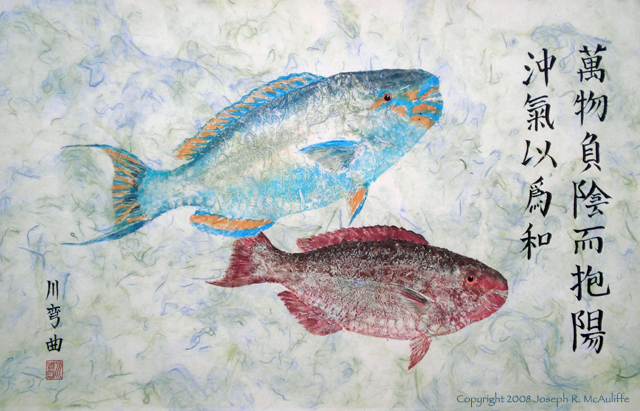
All parrotfish begin their lives as females. Over time, some change sex and transform into highly territorial “supermales.” Increase in size and the development of vibrant color accompany this change in sexual function. The dominance of supermales allows them to defend large feeding territories and to spawn with females drawn to the territory’s more abundant food supply. The pronounced difference in size and coloration of the female and male phases of parrotfish originally caused some confusion among fish biologists trying to classify and name different species. In some cases, the two gender phases of a single species were mistakenly classified as different species.
In the animal world, this kind of gender shift is called sequential hermaphroditism and is ubiquitous among members of the parrotfish family (Scaridae). It also occurs in others like the wrasses (family Labridae). The natural history of sequential hermaphroditism in fishes is fascinating. In some families, including the parrotfishes and wrasses, fish start life as females and then later change into males. In those two families with territorial fish, the gender shift from a smaller female to a larger male increases the individual’s reproductive success.
Conversely, there are some fish species that start out as males, but later turn into females. The moi of the Hawaiian Islands is one of these (see The Fish of Kings). Moi are not territorial, but instead reproduce in large spawning groups where all individuals collectively shed their eggs and sperm. The number of eggs that a fish can produce and hold within its body increases exponentially as its length increases. Since territorial defense is not required for reproductive success, an individual achieves greater reproductive success by changing into a female when it is capable of producing larger and larger quantities of eggs. Considered in this light, the interesting question is not why some fish are sequentially hermaphroditic, but why so many are not.
The 12 characters are an excerpt from chapter 42 in the Tao Te Ching, referring to the balance between opposite and complementary yin (female) and yang (male) attributes: “All living things carry yin and embrace yang; by blending the vital energy (qi) of each, harmony is achieved.”
Size: 36 x 24 inches (2007)
Return to Gallery 1.